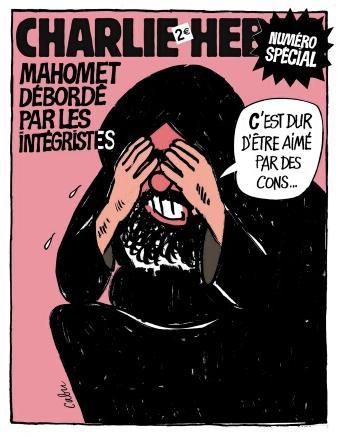The idea of people being killed over the contents of a cartoon sounds like something out of a dystopian sci-fi novel. However, not only is it a reality, it’s not even the first time. January and February of 2006 saw protests spread across many majority-Muslim nations over Danish cartoons which depicted the Prophet Muhammad. 200 people died during the riots, and churches and European embassies were attacked. Death threats were made against the cartoonists and they were forced into hiding.
The response by the world’s media was flaccid. Only very few national newspapers were willing to print the cartoons in solidarity with the Danish cartoonists. The overwhelming majority of national publications shied away from the offending artwork for fear of reprisals. Self-censorship was the objective of the rioters and would-be assassins who threatened the lives of the cartoonists. By refusing to print the cartoons not only did the world’s media surrender to violence but they incentivised violence. By not printing the cartoons they may as well have printed VIOLENCE WORKS in large bold lettering on the front page, because that was the message that was sent. Free speech was abandoned and fear replaced it.
The same mistake cannot be made again. 12 people have lost their lives during the attack on the offices of Charlie Hebdo, a weekly French satirical magazine. Shall the media once again shirk in the face of violence and throw the tenets of free speech by the wayside? The employees of Charlie Hebdo knew what free speech is and were willing to defend it with their lives. They took the brave stance of printing the Danish cartoons in 2006. Their offices were firebombed in 2011 and their website hacked. In 2013 the editor-in-chief Stephane Charbonnier was added to Al-Qaeda’s most wanted list. Despite the danger to their lives the staff of Charlie Hebdo persevered. They responded to these threats against them, these threats agaisnt free speech, the best way they knew how: with free speech. They continued with their satirical cartoons of Muhammad undeterred; thus showing terrorists that violence would not sway them from the values of unfettered free speech. As Charbonnier said “I am not afraid of reprisals, I have no children, no wife, no car, no debt. It might sound a bit pompous, but I’d prefer to die on my feet rather than living on my knees.”
Charbonnier hated the idea of ceding free speech in order to placate violence. It is with deep regret that he had to pay for it with his life. But how will the world’s media react, on their feet with Charbonnier and the rest of his staff or in supplication before violent extremists? Supplication was the preferred option after the Danish cartoon riots, journalistic integrity was discarded and backs were collectively turned on the cartoonists.
Free speech is not something to be taken for granted, we stake such value in it because we know how hard it was to attain, and how rare it is in many parts of the world. Many people have died and suffered so we can enjoy it today. Many people are still dying in parts of the world in order to realise these freedoms. No more so than journalists. Hundreds of journalists worldwide are harassed, imprisoned and even killed for daring to report what they are told they cannot report. What kind of message does it to send those fighting for freedom of speech if those with it relinquish it at drop of a hat? What kind of message does it send those who use violence in order to restrict our freedoms if we let them?
There will, of course, be the usual platitudes: media outlets will decry the attacks, but the cartoons will not be printed; respect will be shown to those who died, but the cartoons will not be printed; the importance of free speech will be emphasised, but the cartoons will not be printed. They will say the right things but will not do the right thing. Without duplication of the cartoons accompanying the sentiment then the words are meaningless.
 If journalistic ethics are to be upheld then the cartoons should be in every newspaper, every news website, and every news channel. It will send a message to terrorists that violence will not be bowed to; free speech will be fought for. Failure to print the cartoons out of fear is to betray journalism, to betray the media outlets brave enough to print the cartoons, and to betray the principles for which the Charlie Hebdo staff died for. In the face of violence and terror they continued to exercise their right to free speech and they paid for it with their lives. To respond to the murders by yielding to fear is antithetical to what they gave their lives for. The cartoons must be printed, it will show that free speech will not be surrendered in the face of violence and it will honour those that have died.
If journalistic ethics are to be upheld then the cartoons should be in every newspaper, every news website, and every news channel. It will send a message to terrorists that violence will not be bowed to; free speech will be fought for. Failure to print the cartoons out of fear is to betray journalism, to betray the media outlets brave enough to print the cartoons, and to betray the principles for which the Charlie Hebdo staff died for. In the face of violence and terror they continued to exercise their right to free speech and they paid for it with their lives. To respond to the murders by yielding to fear is antithetical to what they gave their lives for. The cartoons must be printed, it will show that free speech will not be surrendered in the face of violence and it will honour those that have died.
